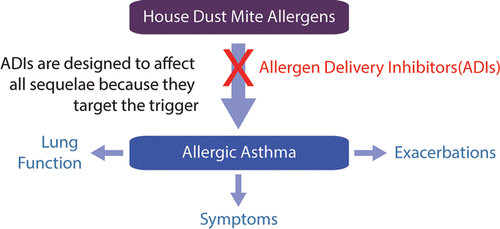Current asthma treatments can alleviate wheezing, coughing and other symptoms felt by millions of Americans every year, but they don't get to the root cause of the condition. Now, for the first time, scientists are reporting a new approach to defeating asthma by targeting the trigger—the allergen—before it can spark an attack. They describe their new compound, which they tested on rats, in ACS' Journal of Medicinal Chemistry.
Clive Robinson and colleagues explain that to prevent many health problems, the ideal approach to treatment or prevention involves getting to the cause of a condition and targeting it directly. Asthma, which occurs when the immune system goes into overdrive affecting the airway in response to an otherwise harmless substance, has posed a challenge to this model. That's because it can be set off by different allergens or irritants. But recent studies suggest that the picture might not be as complicated as previously thought. Scientists have found that dust mites are one of the most important triggers of allergic asthma. So Robinson's team wanted to find a way to neutralize mite allergens.
The researchers identified a compound that binds to a major dust mite allergen and turned it into an inhalable powder. They tested it on rats and found that it significantly dampened the animals' immune response when they were exposed to a variety of allergens. This compound and other similar inhibitors could hail a new direction in asthma treatment, say the researchers.
More information: "The Discovery of Potent, Selective, and Reversible Inhibitors of the House Dust Mite Peptidase Allergen Der p 1: An Innovative Approach to the Treatment of Allergic Asthma" J. Med. Chem., 2014, 57 (22), pp 9447–9462, DOI: 10.1021/jm501102h
Abstract
Blocking the bioactivity of allergens is conceptually attractive as a small-molecule therapy for allergic diseases but has not been attempted previously. Group 1 allergens of house dust mites (HDM) are meaningful targets in this quest because they are globally prevalent and clinically important triggers of allergic asthma. Group 1 HDM allergens are cysteine peptidases whose proteolytic activity triggers essential steps in the allergy cascade. Using the HDM allergen Der p 1 as an archetype for structure-based drug discovery, we have identified a series of novel, reversible inhibitors. Potency and selectivity were manipulated by optimizing drug interactions with enzyme binding pockets, while variation of terminal groups conferred the physicochemical and pharmacokinetic attributes required for inhaled delivery. Studies in animals challenged with the gamut of HDM allergens showed an attenuation of allergic responses by targeting just a single component, namely, Der p 1. Our findings suggest that these inhibitors may be used as novel therapies for allergic asthma.
Journal information: Journal of Medicinal Chemistry
Provided by American Chemical Society





















